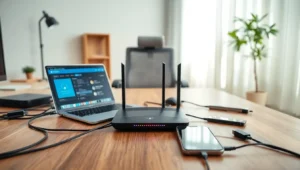Imagine transforming your living room into a personal cinema, where binge-watching your favorite shows is just a click away. Setting up a Plex server isn’t just for tech wizards; it’s for anyone who loves their movies and TV series without the hassle of endless streaming subscriptions. With Plex, he can organize all his media into one sleek interface, making it easier than ever to find that hidden gem he’s been meaning to watch.
Table of Contents
ToggleWhat Is Plex Server?
Plex server is a media management solution that allows users to organize, stream, and share personal collections of movies, TV shows, music, and photos. This software creates a central hub for media accessing from various devices, such as smartphones, tablets, smart TVs, and computers.
Users can easily install Plex on various operating systems, including Windows, macOS, and Linux. Once set up, the server scans local media libraries and organizes content into an intuitive interface. This interface simplifies the process of locating favorite titles without navigating multiple platforms.
The server supports numerous file formats, ensuring compatibility with most media types. It also provides features like parental controls, allowing families to manage content access. Remote access enables users to stream their content even when away from home, contributing to a seamless viewing experience.
Plex server enhances enjoyment through automatic metadata fetching. It retrieves information such as cover art, plot summaries, and genre classifications, enriching the media experience. Users can customize libraries by creating playlists, combining titles, or grouping content by themes or genres.
A community-driven ecosystem surrounds Plex, encouraging sharing among users. Individuals can collaborate to enhance the media libraries with additional content, enrich their collection, and discover new favorites. Regular updates keep the software reliable, introducing new features and addressing potential issues.
With these advantages, Plex server delivers convenience, flexibility, and a personalized media experience that transforms home entertainment.
Benefits Of Using Plex Server
Plex server delivers numerous advantages for users looking to enhance their media experience. This includes improved organization and accessibility for various types of content.
Enhanced Media Management
Enhanced media management transforms how users interact with their collections. Plex organizes movies, TV shows, music, and photos in a single interface. Users can easily locate content without navigating multiple platforms. Automatic metadata fetching adds cover art and information like plot summaries. Customization options let users tailor their libraries according to preferences. Parental controls ensure age-appropriate content access for families, enhancing user control and experience.
Accessibility Across Devices
Accessibility across devices makes Plex a versatile solution. Users stream media on smartphones, tablets, smart TVs, and computers without limitations. The server accommodates various operating systems, ensuring compatibility. Remote access allows users to enjoy content anywhere with an internet connection. Synchronization ensures consistent media libraries across devices. This flexibility creates a seamless viewing experience, whether at home or on the go. Users can manage and enjoy their media collections anytime, further emphasizing Plex’s convenience.
How To Set Up A Plex Server
Setting up a Plex server involves meeting specific system requirements, going through an installation process, and completing configuration steps. Following these guidelines ensures a smooth experience.
System Requirements
A Plex server operates effectively on various platforms. Users can choose from Windows, macOS, or Linux for installation. At least 2 GB of RAM ensures proper performance. Storage space must accommodate a media library; a few hundred gigabytes is common. Internet connectivity is crucial, particularly for remote access. Devices like smart TVs and smartphones must support the Plex app to access the media library seamlessly.
Installation Process
To install Plex, users start by downloading the latest version from the official Plex website. After downloading, the installation file prompts the user to follow on-screen instructions to complete the setup. Users then create a Plex account or log in with an existing one during installation. After the setup, launching the Plex Media Server application allows it to scan for local media files and organize them into a library.
Configuration Steps
Configuring a Plex server involves several essential steps. Users should designate specific folders for movies, TV shows, music, and photos. Customizing library settings, including selecting appropriate genres and metadata, enhances organization. Enabling remote access allows users to stream content away from home. Adjusting parental controls ensures a safe viewing experience for children. Completing these configuration steps sets the stage for an optimized media experience.
Troubleshooting Common Issues
Plex server users may encounter various issues. Understanding common problems and their solutions streamlines the media experience.
Performance Problems
Performance issues often arise during streaming. Users may notice buffering or poor video quality. Starting by checking the server’s hardware specifications helps identify limitations. Ensuring the media files are compatible with Plex further improves streaming quality. Running a network speed test can detect bandwidth issues. Lowering video quality in the settings provides a quick workaround. Lastly, an overloaded server can slow down performance; reducing the number of concurrent streams enhances responsiveness.
Connectivity Issues
Connectivity problems disrupt the enjoyment of media content. Users frequently experience difficulties connecting to their Plex server remotely. First, checking the server’s local IP address ensures it’s accessible within the network. Looking at firewall settings can reveal blocked connections; adding exceptions for Plex may resolve this. Updating the server software often fixes connectivity glitches. If using a VPN, ensuring it’s configured correctly prevents conflicts. Restarting the server and router can refresh connections and improve accessibility.
Conclusion
Setting up a Plex server opens the door to a world of personalized entertainment. It empowers users to curate their media collections and enjoy seamless streaming across various devices. With its user-friendly interface and robust features, Plex transforms how individuals interact with their favorite movies, shows, and music.
By following the straightforward setup guidelines and troubleshooting tips, anyone can create a reliable media hub in their home. The convenience of accessing a well-organized library anytime, anywhere makes Plex an invaluable addition to modern entertainment systems. Embracing this technology not only simplifies media management but also enhances the overall viewing experience for everyone in the household.





